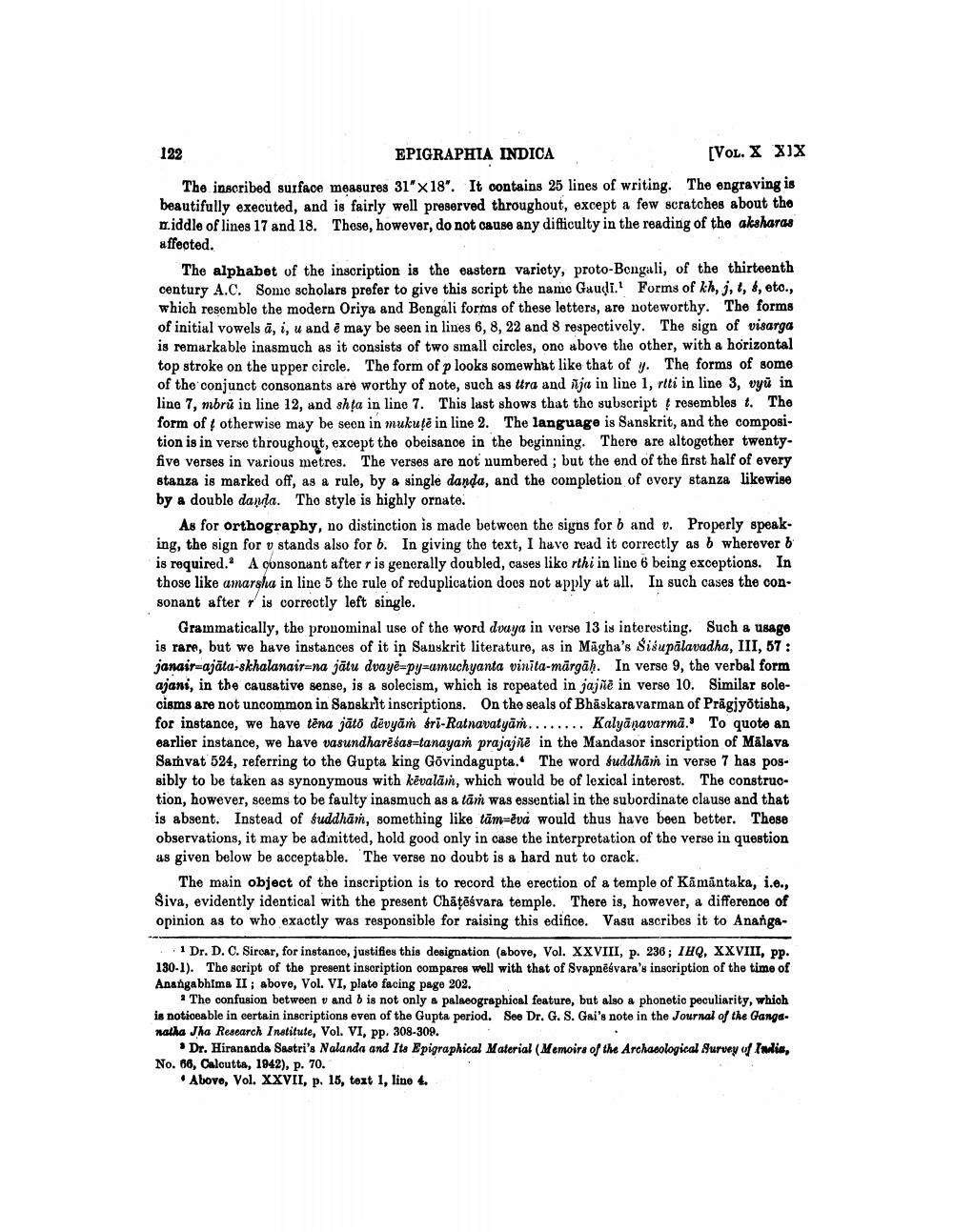________________
122 EPIGRAPHIA INDICA
[Vol. X XIX The inscribed surface measures 31" X 18". It contains 25 lines of writing. The engraving is beautifully executed, and is fairly well preserved throughout, except a few scratches about the m.iddle of lines 17 and 18. Those, however, do not cause any difficulty in the reading of the aksharas affected.
The alphabet of the inscription is the eastern variety, proto-Bengali, of the thirteenth century A.C. Some scholars prefer to give this script the name Gaudi. Forms of kh, j, i, &, etc., which resemble the modern Oriya and Bengali forms of these letters, are noteworthy. The forms of initial vowels a, i, u and ê may be seen in lines 6, 8, 22 and 8 respectively. The sign of visarga is remarkable inasmuch as it consists of two small circles, one above the other, with a horizontal top stroke on the upper circle. The form of p looks somewhat like that of y. The forms of some of the conjunct consonants are worthy of note, such as ttra and nja in line 1, rtti in line 3, vyū in line 7, mbrü in line 12, and shța in line 7. This last shows that the subscript resembles t. The form of otherwise may be seen in mukute in line 2. The language is Sanskrit, and the composition is in verse throughout, except the obeisance in the beginning. There are altogether twentyfive verses in various metres. The verses are not numbered ; but the end of the first half of every stanza is marked off, as a rule, by a single danda, and the completion of ovory stanza likewise by a double danda. The style is highly ornate.
As for orthography, no distinction is made between the signs for b and v. Properly speaking, the sign for v stands also for b. In giving the text, I have read it correctly as b wherever b is required. A consonant after r is generally doubled, cases liko rthi in line 6 being exceptions. In those like amarsha in line 5 the rule of reduplication does not apply at all. In such cases the consonant after r is correctly left single.
Grammatically, the pronominal use of the word dvaya in verse 13 is interesting. Such a usage is rare, but we have instances of it in Sanskrit literature, as in Mägha's Sisupälavadha, III, 57: janair-ajāta-skhalanair na jātu dvayê=py=amuchyanta vinita-märgā). In verse 9, the verbal form ajani, in the causative sense, is a solecism, which is repeated in jajna in verso 10. Similar soleciems are not uncommon in Sanskrit inscriptions. On the seals of Bhāskara varman of Prāgjyotisha, for instance, we have tēna jāto dēvyāṁ fri-Ratnavatyāṁ........ Kalyānavarma. To quote an earlier instance, we have vasundharēsastanayam prajajse in the Mandasor inscription of Mālava Samvat 524, referring to the Gupta king Govindagupta.. The word fuddhān in verse 7 has pog. sibly to be taken as synonymous with kēvalān, which would be of lexical interost. The construction, however, seems to be faulty inasmuch as a tāṁ was essential in the subordinate clause and that is absent. Instead of suddhām, something like tām-eva would thus have been better. These observations, it may be admitted, hold good only in case the interpretation of the verse in question as given below be acceptable. The verse no doubt is a hard nut to crack.
The main object of the inscription is to record the erection of a temple of Kämántaka, i.e., Siva, evidently identical with the present Chātāśvara temple. There is, however, a difference of opinion as to who exactly was responsible for raising this edifice. Vasu ascribes it to Ananga
. . 1 Dr. D. C. Sircar, for instance, justifies this designation (above, Vol. XXVIII, p. 236; IHQ, XXVIII, pp. 130-1). The script of the present inscription compares well with that of Svapnēgvara's inscription of the time of Anangabhima II ; above, Vol. VI, plate facing page 202.
The confusion between vand is not only a palaeographical feature, but also a phonetic peculiarity, which is notioeable in certain inscriptions even of the Gupta period. See Dr. G. S. Gai's note in the Journal of the Ganganatha Jha Research Institute, Vol. VI, pp. 308-309.
Dr. Hirananda Sastri's Nalanda and Its Epigraphical Material (Memoirs of the Archaeological Survey of India, No. 66, Calcutta, 1942), p. 70.
Above, Vol. XXVII, p. 15, text 1, line 4.




